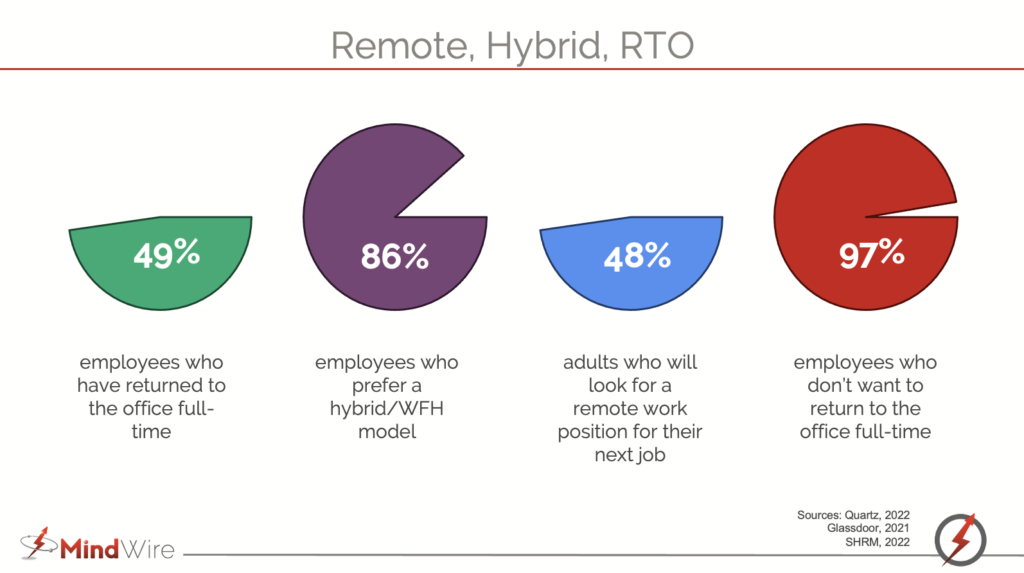
Navigating the Talent Landscape: Key Takeaways
If you’ve been wondering about the evolving landscape of talent acquisition, you’re not alone. As organizations adapt to rapid changes and a shifting workforce, having a solid talent strategy becomes paramount.
Jennifer Bookspan, CEO of Forbes.Jobs, joined us recently in a robust dialogue to explore the practical ways strategic planning can help you stay ahead in this dynamic talent environment. This blog outlines the key takeaways to give you actionable insights to navigate the talent landscape successfully.
What Are the Key Trends Shaping Talent Acquisition?
Key Trends: Staying Ahead of the Curve
As we move into the future and plan for our people strategies, the talent landscape is experiencing some noteworthy shifts. Here are some key trends that can’t be ignored:
- The Five-Generation Workforce: With baby boomers transitioning into retirement at an unprecedented rate (and when we say unprecedented, we mean 12K baby boomers a day will turn 65), it’s essential to prepare the next generation of leaders. Plan to tap into the potential of your non-baby boomer employees for leadership positions sooner, not later.
- Talent Shortage: Recent data from the Bureau of Labor Statistics reveals a significant gap between job openings and available workers. In fact, for every 100 open jobs in the US, there are 76 people to fill those roles. Start building your plans to address the talent shortage.
- The Remote Work Revolution: In response to market dynamics, remote work and flexible arrangements are becoming increasingly important to non-baby boomer employees. Equally as important are career growth, development, and a caring manager. This change represents a significant shift. In your next talent strategy, consider addressing these critical needs.
How Do You Build an Attractive Employer Brand?
Enhancing Your Employer Brand: Authenticity Matters
Candidates now research organizations extensively before even applying. They’re looking for authenticity, a healthy work environment, and values that align with their own. To build an attractive employer brand, ask yourself these questions:
- Culture, Values, and Purpose: Does your organization’s culture align with your stated values and purpose, and is that cultureit authentically reflected in your employer brand?
- Diversity, Equity, Inclusion, and Belonging (DEIB): How robust is your DEIB strategy, and how effectively is it communicated to potential candidates?
- Healthy Environment Strategy: Does your organization promote a healthy work environment? While this can certainly include treadmill desks for all, this also includes mental health resources. Talent now and into the future will want a safe workplace to express their viewpoints and have reasonable work demands. What steps are you taking to ensure a healthy environment is part of your strategy?
How Can You Improve the Candidate and Employee Experience?
Candidate and Employee Experience: Eliminating Friction
Creating remarkable experiences for your candidates and employees is essential.
Candidate experience refers to the overall perception, feelings, and interactions that job candidates have when they engage with an organization’s recruitment and hiring process. It encompasses every stage of the candidate journey, from the initial job application to the final hiring decision or rejection. A positive candidate experience is characterized by clear and transparent communication, respectful and efficient interactions, and a process that respects the candidate’s time and effort. These elementsIt can significantly impact an organization’s ability to attract and retain top talent, as candidates who have a positive experience are more likely to view the company favorably, even if they don’t receive a job offer. Conversely, a negative candidate experience can deter potential employees from pursuing opportunities with the organization and can even harm the company’s reputation in the job market.
On the other hand, an employee experience encompasses the sum of all interactions, perceptions, and feelings that an individual employee has during their entire journey with an organization, from the initial stages of recruitment to their exit from the company. This includes the workplace culture, work environment, relationships with colleagues and supervisors, opportunities for growth and development, compensation, benefits, and the overall work-related experiences.
To improve these experiences for your talent, start by asking these questions:
- Job Descriptions: Are your job descriptions clear and concise, outlining only essential requirements and leaving room for on-the-job learning?
- High Touch and Responsiveness: How high-touch is your engagement with candidates, and how quickly do you respond to inquiries?
- Candor and Transparency: How candid and transparent are you in your communication with candidates and employees?
What About Skills Development?
Skills Development: Exploring Non-Traditional Avenues
The demand for skills development is ever-present, but the methods of delivering it are evolving. How can you develop your employees’ skills while keeping costs in check? Consider these non-traditional approaches:
- Skill Building on a Budget: Explore cost-effective ways to develop skills without breaking the bank such as in-house mentoring and peer-learning.
- Technological Proficiency: Evaluate how your employees engage with your technology and systems, and prioritize what needs immediate attention.
- Build Skill Development into Your Strategy: Complete a cost-benefit analysis of up-skilling your internal teams to develop and grow with your organization, as opposed to the cost of external hires, and how development aligns with your organization’s culture and values.
What’s the Role of Flexibility in Your Talent Strategy?
Flexibility: A Gateway to New Talent
In a landscape where the war for talent intensifies, flexibility can be a game-changer. For roles that don’t permit remote work, consider other forms of flexibility like flexible work hours, mental health PTO days, or compensation for travel time. One thing very clear from the webinar is that 97% of employees don’t want to return to the office full-time and 86% would prefer a hybrid / WFH model.

Return to work is not one-size-fits-all, but considering flexible options for your workforce is critical to remaining competitive.
How Can You Attract and Retain Underrepresented Talent?
Diversity and Inclusion: Expanding Your Talent Pipeline
To build a diverse and inclusive workforce, it’s crucial to attract and retain underrepresented talent. Underrepresented talent does not mean under talented. But it is critical to remember that underrepresented groups and certain types of candidates will want to check off every “requirement” in the job ad. It is typically those in talent groups that are well represented that are more likely to “figure it out as they go” and take bigger risks when applying. Don’t be that employer that unintentionally shuts off the funnel to underrepresented groups. Here are some questions to get your thoughts started:
- Eliminating Unnecessary Requirements: Are you willing to reconsider job requirements that might deter underrepresented groups?
- Meeting Candidates Where They Are: How are you reaching out to underrepresented talent, and what steps are you taking to make them feel welcome?
Are There Opportunities for Fractional and Project-Based Work?
Adapting to a Changing Workforce
There’s a growing trend of retirees and experienced professionals seeking fractional and project-based work. Often, these people are not doing it for the money but instead, for the impact. This provides an impeccable opportunity for businesses to tap incredible talent while also getting them at an affordable rate. How might you tap into this pool of qualified and experienced talent?
What Appeals to the Next Generation of Talent?
Catering to Future Talent Expectations
There are three big components that non-baby boomer talent is asking for:
- Growth and development. The opportunity to grow and develop looks different for each individual. Some want to go deeper into their technical expertise, others want to try new things. The important component is to map employee growth expectations and fulfill them.
- Sustainable work expectations. This means not throwing the kitchen sink at your employees, even if you are a rapidly growing start up with team members who wear many hats. Define their role with measurable results, key behaviors, and ideal outcomes.
- Caring leadership. To be a caring leader means you empathize with the employee, anticipate their drivers and needs, and adjust your own style to match their own.
How can you align your talent strategy with these expectations?
Where to Begin with Your Talent Strategy?
Getting Started: Actionable Steps
You now have a wealth of insights, but where should you begin with your talent strategy? Here are some ways to get started:
- Identify Key Hires: Start engaging with potential hires well in advance, even if they won’t be onboarded for a year or more.
- Process Optimization: Fix any process bottlenecks or issues that can be easily addressed.
- Developing Managers: Focus on developing early-stage managers and front-line supervisors.
- Empower Growth: Provide opportunities for growth and development to your team, regardless of their role.
- Audit Your Brand and Culture: Assess your organization’s strengths and build upon them.
Navigating the talent landscape of the future requires strategic thinking, adaptability, and a keen focus on your organization’s unique needs. By addressing these questions and implementing the key takeaways, you can stay ahead in the world of talent acquisition and ensure your organization’s continued success in the years to come.
Don’t miss the chance to be a leader in talent strategy by sculpting your strategic plans with your talent in mind. In the meantime, we’ll keep a watchful eye on the evolving talent landscape as it continues to shape the future of work and keep you informed.
Simplify Your People Challenges
Overcome obstacles and propel your organization forward so you can yield results as impressive as assembling Ikea furniture without any leftover parts.


